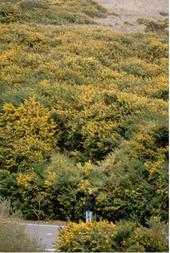- Author: Mackenzie Patton
- Posted by: Gale Perez

The Invasive Pest Spotlight focuses on relevant or emerging invasive species in California. In this issue we are covering brooms, a group of invasive shrubs.
Invasive Broom facts
Brooms are upright shrubs in the legume family that typically produce small, yellow, pea-shaped flowers. Shrubs range from 3 to 10 feet tall. They produce flowers from mid spring to summer and produce seed pods in late summer. All brooms are prolific seed producers, with a single shrub producing as many as 2,000 to 3,500 pods containing up to 20,000 seeds.
While brooms are attractive plants, they grow in dense stands that outcompete many native plants....
- Author: Whitney B Brim-Deforest
- Editor: Taiyu Guan
- Editor: Consuelo Baez Vega
- Posted by: Gale Perez

From the UC Rice Blog :: August 23, 2023
* * * * * * * * * *
Pest Control Advisers (PCAs) and growers were very creative and timely in planning and applying products this year, and control was good in many fields. The two most widespread weed control problems that I noticed this year were the watergrass complex and sprangletop. We have widespread resistance, but control issues this year were likely also related to the wet spring, as well as colder temperatures which resulted in different emergence timings and weed growth patterns as compared...
- Author: Trina Kleist
- Posted by: Gale Perez

It all started with pumpkin seeds
Justin Valliere has been hired to expand the Department of Plant Sciences' reach in the fields of invasion and restoration ecology. Valliere started as an assistant professor of UC Cooperative Extension in July.
Valliere seeks ways to restore California's native plant communities amid the onslaught of invasive plants and a range of environmental changes. He thinks it's important to bring youngsters into the research world, training them to care about nature and inspiring them to form the next generation of restoration professionals. Cooperative Extension offers a great way to...
- Author: Konrad Mathesius

Summary note: This is a belated research update from herbicide trials (targeting Italian ryegrass) carried out in the winter of 2021-2022 in wheat fields in the Esparto area. The southern Sacramento Valley saw a record number of consecutive days without rain in that year, which severely limited the efficacy of post-emergent systemic herbicides. Growers should prioritize scheduling post-emergent herbicide applications early in the weed's growth stages and when weeds are actively growing to avoid the severe reduction of herbicide efficacy that can occur as a result of unexpected droughty conditions. This is particularly important given that the weather systems in our...
- Author: Pershang Hosseini
- Author: Bradley Hanson
- Posted by: Gale Perez

Quaternary ammonium compounds (QAC) are surface-active chemicals that are widely used for surface sanitation in the food processing industry, disinfectants, fabric softeners, and cosmetics. They are designed to remain stable and effective in water-based solutions. QACs typically are diluted with water so they can be applied in higher volumes which helps to facilitate their dispersal and allows them to interact with target surfaces or organisms. In several related lines of research funded by the California Tomato Research Institute, the California Specialty Crop Block Grant Program, and the California League of Food Processors, UC Davis researchers are evaluating QAC efficacy on broomrape seeds and soil-borne pathogens. The main goal of...


